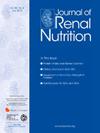中晚期慢性肾病患者血浆中三甲胺-N-氧化物、胆碱和甜菜碱的浓度及其与心血管和肾脏预后的关系。
IF 3.4
3区 医学
Q2 NUTRITION & DIETETICS
引用次数: 0
摘要
目的:三甲胺 N-氧化物(TMAO)是由肠道细菌介导的饮食中甜菜碱、胆碱和肉碱的肝脏代谢产物,通过肾小球滤过排出体外。我们研究了 TMAO 是否与慢性肾脏病(CKD)患者的心血管疾病(CVD)有关:在 478 名 CKD 分期为 G2(104 人)、G3a(163 人)、G3b(123 人)和 G4(88 人)的患者中,我们研究了基线时空腹血浆中 TMAO、胆碱或甜菜碱浓度与肾功能、流行性心血管疾病以及平均随访 5.1 年的未来肾脏预后之间的关系:结果:肾小球滤过率降低与血浆中 TMAO、胆碱和甜菜碱浓度升高有关。与无心血管疾病者相比,已有心血管疾病者的TMAO基线浓度更高(8.4 [10.1] μmol/L vs. 7.8 [8.0] μmol/L;p = 0.047),但在调整了混杂因素后,差异并不显著。在随访期间,147 名参与者出现心血管疾病或死亡,144 名达到预定的肾脏终点。在调整后的回归分析中,TMAO或胆碱浓度处于较高的三个四分位数(相对于最低的四分位数)与任何研究临床终点均无关联。相反,血浆甜菜碱浓度在最高四分位数与最低四分位数之间的调整危险比分别为:心血管疾病终点为 2.14 (1.32, 3.47),肾脏疾病终点为 1.64 (1.00, 2.67):血浆中 TMAO 浓度升高的原因是肾功能受损。甜菜碱血浆浓度升高可预测不良后果,而TMAO或胆碱血浆浓度升高则不能预测不良后果。TMAO可能不是降低已有慢性肾脏病患者心血管疾病或肾脏疾病预后的合适目标。本文章由计算机程序翻译,如有差异,请以英文原文为准。
Plasma Concentrations of Trimethylamine-N-Oxide, Choline, and Betaine in Patients With Moderate to Advanced Chronic Kidney Disease and Their Relation to Cardiovascular and Renal Outcomes
Objectives
Trimethylamine N-oxide (TMAO) is a gut bacteria-mediated liver metabolite of dietary betaine, choline, and carnitine, which is excreted by glomerular filtration. We studied whether TMAO is excreted by cardiovascular disease (CVD) in patients with chronic kidney disease (CKD).
Methods
Among 478 patients with CKD stage G2 (n = 104), G3a (n = 163), G3b (n = 123), and G4 (n = 88), we studied the association between fasting plasma concentrations of TMAO, choline, or betaine at baseline and kidney function, prevalent CVD, and future renal outcomes during a mean follow-up of 5.1 years.
Results
Decreased glomerular filtration rate was associated with higher plasma concentrations of TMAO, choline, and betaine. Baseline concentrations of TMAO were higher in participants with preexisting CVD compared to those without CVD (8.4 [10.1] vs. 7.8 [8.0] μmol/L; P = .047), but the difference was not significant after adjusting for confounders. During the follow-up, 147 participants experienced CVD or died, and 144 reached the predefined renal endpoint. In the adjusted regression analyses, TMAO or choline concentrations in the upper three quartiles (vs. the lowest quartile) were not associated with any of the study’s clinical endpoints. In contrast, the adjusted hazard ratio of plasma betaine in the highest quartile versus the lowest quartile was 2.14 (1.32, 3.47) for the CVD endpoint and 1.64 (1.00, 2.67) for the renal endpoint.
Conclusions
Elevated plasma TMAO concentrations were explained by impaired kidney function. Elevated plasma concentrations of betaine, but not those of TMAO or choline, constituted a risk factor for adverse outcomes. TMAO might not be an appropriate target to reduce CVD or renal outcomes in patients with preexisting CKD.
求助全文
通过发布文献求助,成功后即可免费获取论文全文。
去求助
来源期刊

Journal of Renal Nutrition
医学-泌尿学与肾脏学
CiteScore
5.70
自引率
12.50%
发文量
146
审稿时长
6.7 weeks
期刊介绍:
The Journal of Renal Nutrition is devoted exclusively to renal nutrition science and renal dietetics. Its content is appropriate for nutritionists, physicians and researchers working in nephrology. Each issue contains a state-of-the-art review, original research, articles on the clinical management and education of patients, a current literature review, and nutritional analysis of food products that have clinical relevance.
 求助内容:
求助内容: 应助结果提醒方式:
应助结果提醒方式:


